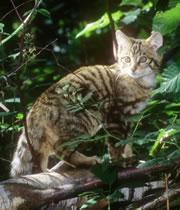 Scottish wildcat: interbreeding with feral cats is diluting its genes.Ewan Macdonald
Scottish wildcat: interbreeding with feral cats is diluting its genes.Ewan MacdonaldDomestic cats have been worshiped as gods, reviled as devils and cherished as companions. News@nature.com looks at the feline family tree to find out when and where humans began to welcome cats into their homes.
Where did cats come from?
According to a new genetic analysis, modern-day housecats are descended from a population of domesticated wildcats that prowled the Middle East more than 100,000 years ago.
How did they figure that out?
Carlos Driscoll, a zoologist working at Oxford University and the US National Cancer Institute in Frederick, Maryland, and his colleagues surveyed 979 cats from around the globe, including wildcats, feral cats, various domesticated breeds, sand cats and Chinese desert cats.
By comparing genome sequences, the researchers worked out the relationships between the different animals. The goal, the authors say, was to find "the archaeological imprints left in the genomes of living cats".
DNA shows that domestic cats are most similar to wildcats currently living in the deserts of Israel, United Arab Emirates, Bahrain and Saudi Arabia. The results are published this week in Science1.
"We found five distinct lineages dating back 100,000 years prior to any archaeological record of cat domestication," says David Macdonald, a zoologist at Oxford University and a co-author on the study. "These appear to come from at least five female cats from the Near East whose descendants have been transported across the world by humans."
But I thought Fluffy was descended from Egyptian cats that were worshiped as gods.
Not necessarily. Although the Egyptians had a healthy respect for their regal felines, they probably weren't the first to welcome the animals into their homes.
Three years ago, scientists reported the discovery of a 9,500-year-old burial site in Cyprus containing a human and a cat2. This was interpreted as evidence that the animal was tamed and then buried with its owner, thousands of years before Egyptians worshipped Bast, a goddess sometimes depicted in cat form.
"The association of a cat and a human in death is strong evidence of association in life," says Jean-Denis Vigne, an archaeologist at the Museum of Natural History in Paris who worked on the discovery. But Vigne adds that this is not strong evidence that the society had embraced feline companionship. "This was a tight relationship between one human and one cat," he says.
Some believe even that goes too far. "There is no evidence of taming," says Tom Rothwell, of the American Museum of Natural History in New York. "This is just some human being who was buried with a cat." If the cat were a pet, Rothwell says, the tomb should contain a collar, harness, or food bowl.
Rothwell argues that the first firm evidence of cat domestication comes from a 2,500-year-old Egyptian mural showing a cat tethered to a chair and playing with a mouse.
So how did cats become pets?
Although the family tree shows the domestic cat branch originating over 100,000 years ago, this doesn't mean that cats were domesticated at this time. It just means that the population that lead to domesticated cats and Middle Eastern wildcats split off from the other wildcats around then.
Regarding domestication, the theory is that when hunter-gatherers became farmers, they began to store grain. The grain attracted rodents, which probably attracted wildcats, which gradually ingratiated themselves with their human neighbours. Vigne says he expects evidence of cat domestication dating from near the beginning of cereal stocks about 12,000 years ago to turn up eventually.
Of the 37 species in the cat family, the domestic cat is the only one that isn't endangered or threatened; there are an estimated 600 million worldwide.
Well I'll be sure to mention all of this at my next cocktail party. But can you do anything with this information?
Driscoll began the project while looking for a way to distinguish feral domestic cats from endangered Scottish wildcats, which are virtually identical to large domesticated tabbies.
ADVERTISEMENT
The two populations can also interbreed. And because domesticated female cats can breed several times each year, whereas female wildcats breed only once per year, the genes of domesticated cats may be diluting the wildcat stock.
"That threatens the genetic integrity of the wildcat," says Driscoll. It also makes it difficult to determine how many wildcats are left.
Driscoll's analysis showed that genes are flowing from domesticated cats to wildcat populations. With his new genetic markers, Driscoll plans to conduct a census of Scottish wildcats, to work out how many are left.
Visit our ofthedesertontothe_so.html">newsblog to read and post comments about this story.
